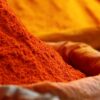Ethiopians love eating injera (a sourdough spongy flatbread the size of a pizza pan that goes with pretty much anything you can think of, from sauces and stews to meat) every day. They do so by using their hands when sharing this traditional food from communal plates. Note that injera is made from a highly nutritious grain called teff, making this Ethiopian dish a true superfood and a very filling and healthy one!
Because of religious observance, the Ethiopian cuisine is mainly vegan. Most of the times, you can find pasta in restaurants in case you feel like eating something ‘different’ (the most popular options are pasta beu atkilt – with vegetables – and pasta beu siga – with meat-; not quite like eating pasta in Italy, but they do the trick).
Also, be ready to drink lots of the famous Ethiopian coffee called buna! Considered as the birthplace of coffee, it should come as no surprise that drinking it is a deeply-rooted tradition among locals in Ethiopia. As a matter of fact, Ethiopians place high importance on their buna ritual, which is a traditional coffee ceremony to show respect and hospitality to family and friends. It always involves a female figure who first spreads fresh grass and flowers on the floor and table, before burning incense. While the aroma fills the room, she roasts, grinds and brews the coffee beans. Finally, the coffee is served in small cups (you’re normally expected to drink three of them), along with snacks such as ambasha (a sweet flatbread), bobolino (fried dough bread similar to a donut), kolo (roasted barley) or popcorn. As you can see, the buna coffee ritual is a great occasion to catch up with both loved ones and new acquaintances! And the traditional coffee pots made of clay are so cute, I actually bought one as a souvenir.
Last but not least, let’s cover some beloved national drinks. Spris would be the equivalent of smoothies, although healthier as they feature layered pureed fruit. You’ll find plenty of Ethiopian beers throughout the country too, the most popular brands being Anbessa, Bedele, Habesha, Harar or St George. Finally, the honey wine (known as tej) is another local’s favorite which sort of reminded me of cider back home in the Basque Country.






